
child bike size guide australia
Welcome to our comprehensive guide on choosing the right bike size for your child in Australia. Proper sizing is crucial for safety, confidence, and comfort. This guide will help you navigate the process, ensuring your child enjoys a positive cycling experience. With expert advice and detailed charts, we’ll cover everything from measuring techniques to bike types, making it easier for you to make the best choice for your little one.
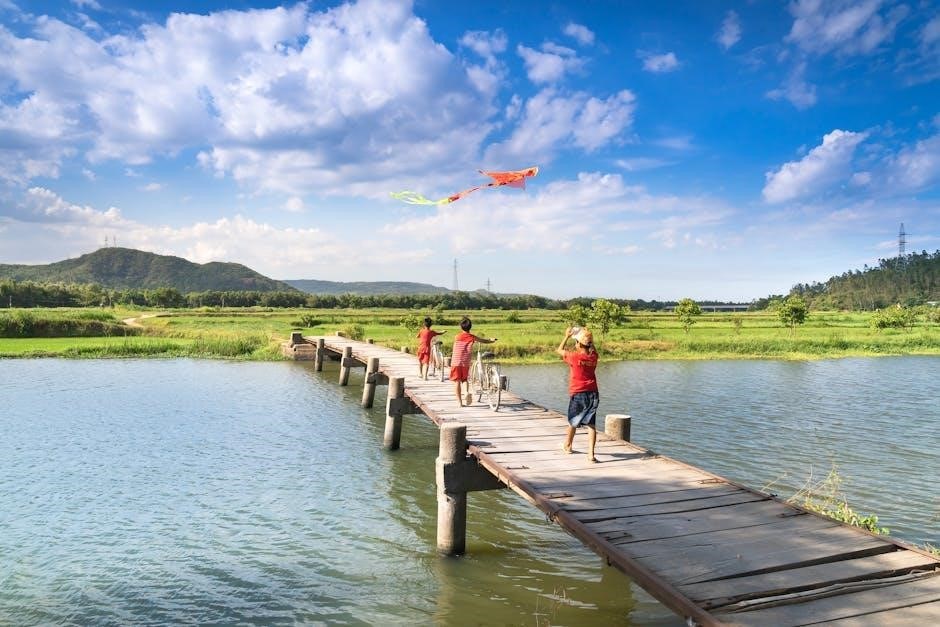
Why the Right Bike Size Matters
Choosing the right bike size for your child is essential for their safety, comfort, and overall cycling experience. A bike that is too small or too large can lead to discomfort, difficulty in handling, and even an increased risk of accidents. When a bike is properly sized, it allows your child to maintain control while riding, which is critical for building confidence and skill, especially for young or inexperienced cyclists.
A well-fitted bike ensures proper posture and balance, reducing the strain on your child’s body. It also makes learning to ride easier and more enjoyable. On the other hand, an ill-fitting bike can discourage your child from cycling due to discomfort or frustration. Additionally, a bike that is the right size grows with your child, providing long-term value and encouraging a lifelong love for cycling.
In Australia, where cycling is a popular family activity, ensuring your child’s bike is the correct size is vital for both on-road and off-road adventures. By prioritizing proper fit, you’re helping your child develop a positive association with cycling while keeping them safe and comfortable. This guide will help you make informed decisions to find the perfect bike for your child.
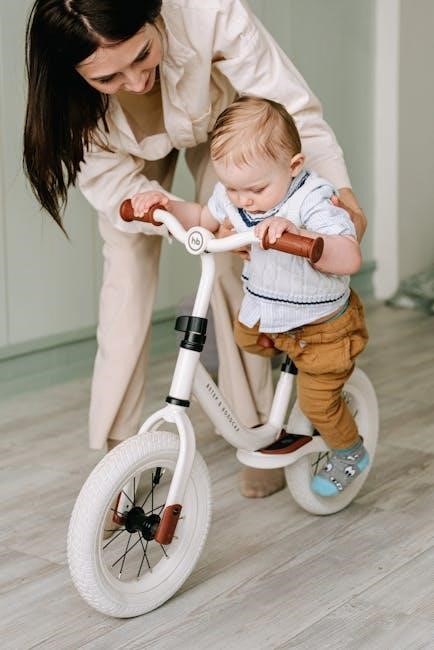
Understanding Bike Sizing for Children
Choosing the right bike size for your child involves considering age, height, and wheel size. Proper sizing ensures comfort, control, and safety. Accurate measurements are key to selecting a bike that supports your child’s growth and riding ability. This guide simplifies the process for Australian families.
3.1 Age-Based Sizing
Age-based sizing is a common method for determining the appropriate bike size for children. In Australia, most bike manufacturers categorize bikes based on age ranges, which are often correlated with wheel sizes. For instance, 12-inch bikes are typically suited for children aged 2-4 years, while 16-inch bikes are recommended for those aged 4-6 years. This approach provides a general guideline, helping parents narrow down their options quickly. However, it’s important to remember that every child is different, and factors like height and leg length can influence the best fit. For example, a taller child may require a larger bike sooner, even if they are younger than the suggested age range. Parents should consider age as a starting point but also assess their child’s physical measurements to ensure optimal comfort and control. Combining age-based sizing with other methods, such as height and inside leg measurements, ensures a more accurate fit. This dual approach helps Australian families find a bike that supports their child’s growth and riding ability effectively.
3.2 Height-Based Sizing
Height-based sizing is a more precise method for determining the right bike size for children in Australia. Bike manufacturers often provide sizing charts that correlate a child’s height with the appropriate wheel size and frame size. For example, a child measuring between 95cm and 110cm in height may suit a 16-inch wheel bike, while a taller child measuring 120cm to 135cm would be better suited to a 20-inch wheel bike. This approach ensures the bike is proportionate to the child’s body, allowing for better control and comfort. Australian bike retailers commonly use height-based sizing charts, making it easier for parents to find the perfect fit. It’s important to measure your child’s height accurately, as this will directly influence the bike’s standover clearance—a critical factor for safety and comfort. Standover clearance refers to the space between the child’s inseam and the bike’s top tube, ensuring they can safely dismount. By focusing on height-based sizing, parents can make informed decisions that prioritize their child’s riding experience and growth. This method is widely recommended in Australia for its accuracy and practicality.
3.3 Wheel Size Guide
Wheel size is a critical factor in determining the right bike for your child, as it directly impacts stability, maneuverability, and overall riding comfort. In Australia, children’s bikes typically range from 12 inches to 26 inches in wheel size, with each size catering to specific age and height groups. A 12-inch wheel bike is ideal for younger children (ages 2-4), while a 16-inch wheel bike suits children aged 4-6. As children grow, they progress to 20-inch and 24-inch wheel bikes, which are designed for older kids (ages 7-10). Finally, a 26-inch wheel bike is often considered a “junior” or “youth” bike, suitable for pre-teens and teenagers. The wheel size ensures the bike is proportional to the child’s height and leg length, providing optimal control and comfort. Australian bike manufacturers and retailers commonly use these wheel size guidelines to help parents choose the right bike. By selecting the appropriate wheel size, you ensure your child can ride safely and confidently, whether on paved paths or off-road trails. This guide helps you navigate the options, ensuring the perfect fit for your child’s needs and abilities.
3.4 Frame Size Importance
The frame size of a child’s bike plays a vital role in ensuring comfort, safety, and proper riding posture. A bike with the correct frame size allows your child to maintain control and enjoy a smooth riding experience. In Australia, frame sizes are typically designed to align with wheel sizes, ensuring proportionality and balance. A well-fitted frame ensures your child can reach the handlebars comfortably and stand over the bike with adequate clearance, reducing the risk of accidents. When selecting a frame, consider the child’s height and inseam measurement, as these directly influence the ideal frame size. Many Australian bike manufacturers offer adjustable frames or frames designed to “grow” with your child, featuring longer seatposts or handlebars that can be raised as they get taller. This adaptability is a practical option for parents who want a bike that lasts for several years. Ultimately, the right frame size ensures your child can ride confidently and safely, whether on urban streets or off-road trails. Always consult a size chart or seek advice from a professional to ensure the best fit for your child’s needs. Proper frame sizing is essential for a positive cycling experience.
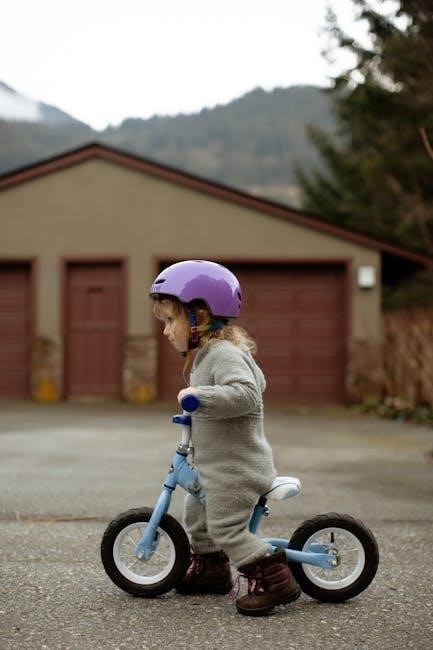
Factors Influencing Bike Size
Several factors influence the right bike size for children, including riding style, terrain type, the child’s ability level, and budget considerations. Each plays a role in selecting the most suitable bike for their needs in Australia.
4.1 Riding Style and Terrain
The riding style and terrain your child will encounter are crucial factors in determining the appropriate bike size. For instance, if your child prefers off-road adventures, a mountain bike with a sturdy frame and larger wheels is ideal. Conversely, for city rides or paved paths, a lightweight hybrid or road bike may be more suitable. The terrain also affects wheel size; rougher surfaces require wider tires for better grip and stability. Additionally, the handlebar height and brake system should be considered based on the type of riding. If your child is still building confidence, a bike with easier-to-reach brakes and a more upright riding position can enhance control. It’s important to match the bike’s features to the primary riding environment to ensure both safety and enjoyment. By aligning the bike’s design with your child’s riding style and the terrain they’ll encounter, you can provide a more comfortable and effective cycling experience. This thoughtful approach ensures the bike grows with your child’s skills and preferences over time.
4.2 Child’s Ability Level
A child’s ability level plays a significant role in determining the right bike size and type. For younger or less experienced riders, balance bikes or bikes with stabilizers are ideal, as they help build confidence and coordination. As children progress in skill, they can transition to bikes with pedals and more advanced features. The bike’s weight and maneuverability are also critical—lighter bikes are easier for children to handle, especially when they are still developing their strength and control. Additionally, bikes with adjustable features, such as brake levers designed for smaller hands, can make a big difference for novice riders. For more experienced children, bikes with gears or suspension systems may be appropriate, offering greater versatility for different riding conditions. It’s important to assess your child’s current skill level and consider how they may grow into a bike over time. Matching the bike to their ability ensures a safer and more enjoyable riding experience, helping them progress smoothly from one stage to the next.
4.3 Budget Considerations
Budget is an essential factor when selecting a child’s bike, as it directly impacts the quality, features, and durability of the bicycle. Setting a clear budget helps narrow down options and ensures you find a bike that offers good value for money. While high-end bikes may offer advanced features like suspension systems or lightweight frames, they can be costly. However, mid-range bikes often provide a great balance between quality and affordability, making them a practical choice for most families. It’s also worth considering that children outgrow bikes quickly, so investing in a high-priced model may not always be necessary. Additionally, many retailers offer sales or discounts, especially during holiday periods, which can help stretch your budget further. Second-hand bikes are another option, but ensure they are in good condition and meet safety standards. Ultimately, prioritizing your child’s needs and riding style within your budget will help you make a wise and economical decision. By focusing on durability and essential features, you can find a bike that meets your budget while providing a safe and enjoyable riding experience for your child.

Child Bike Size Chart
Our child bike size chart provides a clear guide to selecting the right bike based on age, height, and wheel size. Use this chart to ensure your child’s bike fits properly, promoting comfort, safety, and confidence while riding. Accurate measurements are key to the perfect fit.
5.1 Wheel Size and Age Correlation
Understanding the relationship between wheel size and age is essential for selecting the right bike for your child. Generally, younger children (2-4 years) benefit from smaller wheels (12-16 inches), providing stability and ease of control. As children grow, so does the recommended wheel size. For ages 4-6, 16-20 inch wheels are ideal, offering more stability and maneuverability. Older children (7-9 years) typically transition to 20-24 inch wheels, which are closer to adult bike sizes and suitable for more confident riders. For children aged 9 and above, 24-inch wheels are standard, offering advanced features like gears and better performance for various terrains.
This correlation ensures the bike is proportionate to the child’s size, making it easier to handle. Always consider the child’s height and ability level alongside age for the best fit. A bike that’s too large or small can hinder their riding experience. Refer to our detailed chart for precise measurements and recommendations tailored to Australian standards.
5.2 Height and Inside Leg Measurement
Height and inside leg measurement are critical factors in determining the right bike size for your child. A child’s height provides a baseline for bike sizing, ensuring the bike is proportional to their body. Inside leg measurement, or standover height, is equally important, as it determines how comfortably your child can stand over the bike with both feet flat on the ground. For most bikes, the recommended inside leg clearance is 1-2 inches (2.5-5 cm) for safety and comfort.
To measure accurately, have your child stand barefoot or in cycling shoes next to the bike. The standover height should allow them to straddle the bike with a slight gap, ensuring they can mount and dismount safely. Height-based sizing charts typically categorize bikes into small, medium, and large frames, correlating with the child’s growth stages. For example, a child measuring 120-130 cm tall might suit a 20-inch wheel bike, while taller children (140+ cm) may require a 24-inch wheel bike.
Always double-check these measurements against the manufacturer’s guidelines, as frame sizes can vary slightly between brands. This ensures the bike is tailored to your child’s specific needs, promoting confidence and comfort while riding.
5.3 How to Measure Accurately
Measuring your child accurately is essential to ensure the right bike fit. Start by having your child stand barefoot or in cycling shoes against a flat surface, with their feet shoulder-width apart. Use a measuring tape or a sturdy object like a book to measure their height and inside leg length. For height, measure from the top of their head to the floor. For inside leg measurement, place the book between their legs, snug but not too tight, and measure from the floor to the top of the book.
Record these measurements and compare them to a child bike size chart. Australian sizing charts often use a combination of height and inside leg measurements to recommend the appropriate wheel size and frame size. Ensure the bike allows for a small gap (about 1-2 cm) between the child’s crotch and the top tube for safety and comfort. Accurate measurements are crucial to avoid a bike that is too small or too large, which can affect balance and control.
Double-check these measurements against the manufacturer’s sizing guidelines, as some brands may vary slightly. This process ensures your child’s bike is tailored to their needs, promoting confidence and comfort while riding.

Choosing the Right Bike Type
Selecting the right bike type for your child depends on their age, ability, and riding preferences. Balance bikes are perfect for toddlers, while hybrid or road bikes suit older kids for commuting. Mountain bikes are ideal for off-road adventures, offering durability and control. Consider your child’s interests and the terrain they’ll ride on to make the best choice, ensuring comfort and enjoyment. Always test ride if possible and consult with experts for personalized recommendations.
6.1 Balance Bikes for Young Children
Balance bikes are an excellent choice for young children, typically aged 2 to 4 years, as they help develop essential cycling skills. These bikes are designed without pedals, allowing kids to focus on balancing and steering while pushing along the ground with their feet. With a low stand-over height and lightweight frames, balance bikes are easy for little ones to maneuver, boosting their confidence and coordination. They are ideal for toddlers who are just learning to ride, as they eliminate the complexity of pedals and gears, making the transition to a pedal bike much smoother. In Australia, balance bikes are widely recommended by cycling experts and parents alike for their safety and effectiveness in teaching children the fundamentals of cycling. When selecting a balance bike, consider the child’s height and inside leg measurement to ensure proper fit. Look for models with adjustable seat posts and handlebars to accommodate growth. Many balance bikes also feature sturdy, durable designs that can withstand rough play, making them a practical investment for early learners. By starting with a balance bike, you’ll set your child up for a lifelong love of cycling.
6.2 Hybrid and Road Bikes
Hybrid and road bikes are ideal for children who have outgrown balance bikes and are ready for more speed and efficiency. Designed for older kids aged 8 and above, these bikes are perfect for casual rides, commuting, or even competitive events. Hybrid bikes offer a versatile design, combining elements of road and mountain bikes, making them suitable for both on-road and light off-road adventures. They typically feature lightweight frames, multiple gears, and comfortable seating, allowing children to explore various terrains with ease. Road bikes, on the other hand, are built for speed and performance, with slim tires and drop handlebars for a more aerodynamic position. These bikes are best for children who enjoy longer rides or are interested in competitive cycling.
When choosing between hybrid and road bikes, consider your child’s riding style and terrain. Hybrid bikes are great for everyday use, while road bikes are better for paved paths and racing. Ensure the bike fits your child’s height and skill level, and always prioritize safety with proper gear like helmets. By selecting the right hybrid or road bike, your child can enjoy a fun and rewarding cycling experience in Australia.
6.3 Mountain Bikes for Off-Road
Mountain bikes are an excellent choice for children who love off-road adventures and exploring rough terrains. Designed for durability and control, these bikes feature sturdy frames, wide tires with good grip, and suspension systems to handle bumps and uneven surfaces. They are ideal for kids aged 9 and above who enjoy trails, hills, and challenging rides in Australia’s diverse outdoor environments.
When selecting a mountain bike for your child, consider the wheel size, which typically ranges from 20 to 27.5 inches for younger riders, ensuring better maneuverability. Look for bikes with adjustable suspension to accommodate growing skills and varying terrain. The frame size should match your child’s height and leg length to ensure comfort and control. Lighter frames, such as aluminum, are recommended for easier handling.
Mountain bikes are perfect for fostering a sense of adventure and confidence in children. They allow kids to explore nature and develop off-road cycling skills. Always ensure the bike is fitted correctly and that your child wears appropriate safety gear, including a helmet and protective pads, for safe off-road experiences in Australia.
6.4 Specialty Bikes (BMX, Cyclocross)
Specialty bikes like BMX and Cyclocross offer unique features tailored to specific riding styles. BMX bikes are ideal for kids who enjoy tricks, racing, or freestyle riding. These bikes typically feature 20-inch wheels, a compact frame, and a single gear, making them lightweight and easy to maneuver. They are perfect for younger children aged 5–10 years, as they promote balance and agility. Cyclocross bikes, on the other hand, are designed for versatile riding, combining elements of road and off-road cycling. They usually have wider tires, drop handlebars, and a more relaxed frame geometry, making them suitable for older kids aged 8 and above who enjoy exploring mixed terrain.
When choosing a specialty bike, consider your child’s riding style and interests. BMX bikes are great for skills development and stunts, while Cyclocross bikes are ideal for adventurous riders who want to explore both paved paths and light trails. Ensure the bike is correctly sized, with frame proportions matching your child’s height and leg length. Always prioritize safety gear, including a helmet and pads, especially for BMX riding. These bikes can inspire a lifelong passion for cycling and help your child develop specific skills in their preferred discipline.
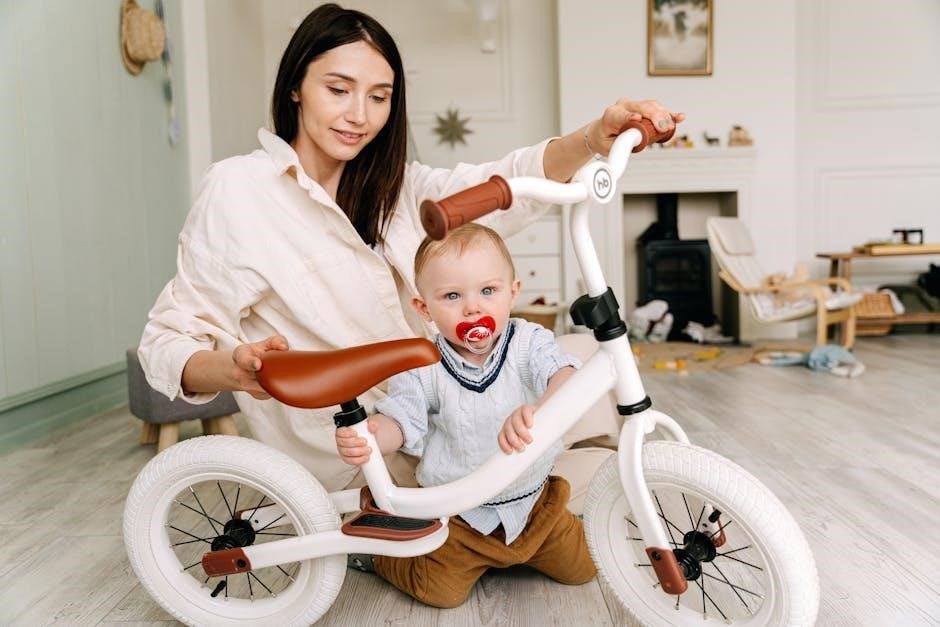
Safety Gear and Accessories
Safety should always be the top priority when it comes to cycling. Ensuring your child wears proper safety gear can significantly reduce the risk of injury. A helmet is the most essential accessory, as it protects the head in case of a fall. Look for a helmet that meets Australian safety standards, such as those set by Standards Australia, and ensure it fits snugly with the chin strap securely fastened.
In addition to a helmet, consider other protective gear like knee pads and elbow pads, especially if your child enjoys off-road riding or BMX tricks. These pads provide cushioning and protection against scrapes and bruises. Reflective accessories, such as stickers or vests, can also enhance visibility, making it easier for drivers to see your child on the road.
A well-maintained bike is also a safe bike. Regularly check the brakes, tires, and chain to ensure everything is in good working condition. Teaching your child to perform basic bike checks can foster responsibility and awareness. Accessories like water bottles, lights, and a bike lock can also enhance their cycling experience. Always prioritize quality and safety when selecting gear for your child.
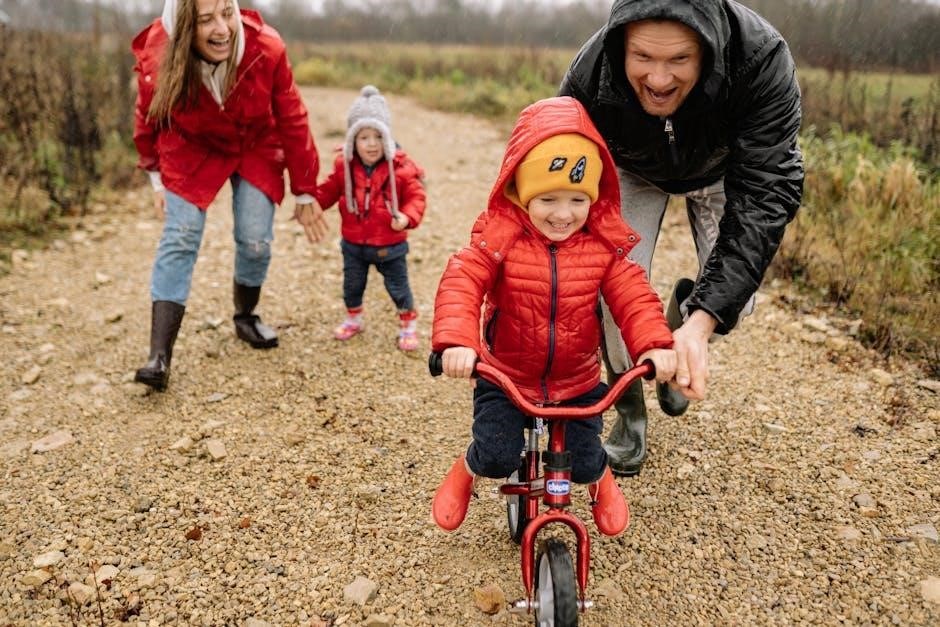
By investing in the right safety gear, you can help your child enjoy cycling with confidence and peace of mind. Remember, safety is not just about gear—it’s also about teaching proper road rules and riding habits. Encourage your child to stay alert, follow traffic signals, and ride defensively to ensure a safe and enjoyable experience on the road.

Proper Bike Setup for Children
Setting up your child’s bike correctly is essential for their comfort, efficiency, and safety while riding. Start by adjusting the seat height to fit their leg length. The saddle should be level, and when they sit with their foot on the pedal in the down position, there should be a slight bend in the knee—about 10-15 degrees. This ensures proper pedaling technique and prevents strain.
The handlebar height should be aligned with the saddle or slightly lower, depending on your child’s preference and riding style. This promotes an upright posture, reducing strain on the neck and back. The distance from the saddle to the handlebars should allow your child to reach comfortably without stretching or hunching.
Ensure the pedals are positioned correctly, with the ball of their foot over the pedal for optimal power transfer. If the bike has gears, teach your child how to use them effectively for different terrains. Regularly check and adjust the bike setup as your child grows, ensuring it continues to fit their needs. Proper setup not only enhances performance but also makes cycling more enjoyable for your child.

Finally, always conduct a quick safety check before each ride, ensuring tires are inflated, brakes function properly, and all bolts are secure. This attention to detail will help your child feel confident and safe on their bike.